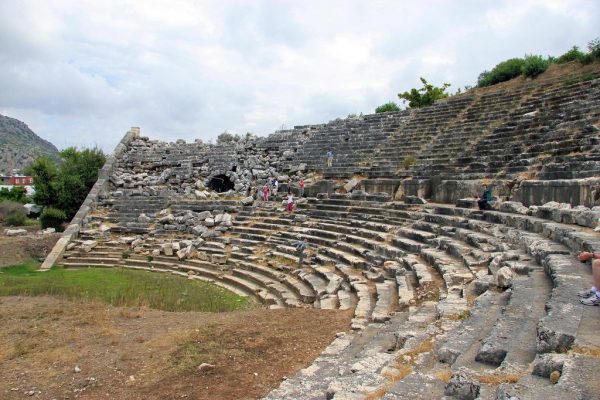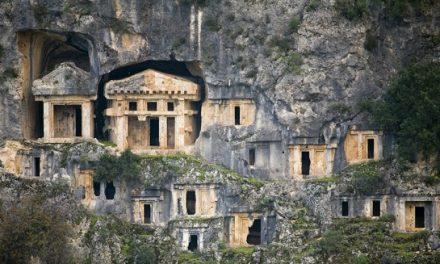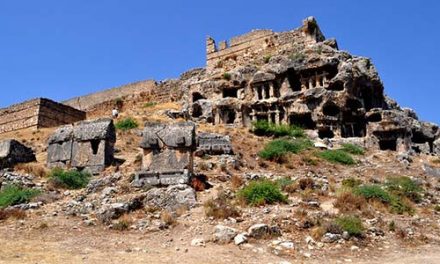Letoon Ancient City is an ancient Lycian settlement located near Kumluova Village at 65th kilometer of Fethiye-Kaş highway connected to Muğla. Since it is the religious center of the Lycian Civilization, it has an important historical place,
When the cult of Apollo spread in Greece, many places produced legends to gain the honor of being the cradle of the god. Delos is also related to such a legend. Of course, what could happen if the Sun God Apollo is from Lycian, the land of light. Moreover, one of his names is Lycian. Letoon Theater (Roman Period) Artemis is a continuation of Anatolia’s mother goddess Cybele and her name in these ages.
The statue of Artemis symbolizing fertility in Ephesus clearly proves this. It is accepted that Leto, the mother of these gods, was from Anatolia and integrated with Kybele. The city of Letoon, founded in the name of Leto, is the sacred center of Lycia.
It has been on the UNESCO World Heritage List together with the Ancient City of Xanthos (Xanthos) since 1988. The ancient cities of Xanthos and Letoon are important elements of the world heritage in terms of the archaeological values they contain. Stone inscriptions, in which the longest and most important texts in the Lycian language can be seen, were found here.
It would be more accurate to say that the Lycian Civilization is a union formed by many small city-states that ruled in the region between Antalya and Muğla, in fact the most democratic union of the ancient period.

Photo by Malcolm Bott on Flickr
Letoon’s History
British Navy lieutenant on the Beacon Ship, Rd. Letoon Ancient City, located 4 kilometers from the UNESCO Heritage Xanthos Ancient City, discovered by Hoskyn.
In Letoon, which has been under the rule of Persians, Carians and ancient Greeks throughout history, the Roman emperor Hadrianus had an imperial cultural center built in his name. The ancient area abandoned after the Roman period, M.S. Christianity came with the church built in the 5th century. Thus, polytheistic religions were abandoned. However, the sanctuary was completely abandoned in the 7th century.
In 1962, Prof. Dr. The city was tried to be brought to light with the excavations started by H. Metzger and then carried out by Christian Le Roy. VIII. It has proven to be centuries old.
Letoon, which was abandoned in the 7th century AD according to known history, is also a part of the Lycian Way walking route that starts from Fethiye and extends to Antalya.
The ancient city, which is on the UNESCO World Heritage List, is on the Lycian walking route. Every day, hundreds of tourists come from environmental tourism centers such as Kaş, Fethiye, Kalkan, Patara to explore this area.

Photo by Malcolm Bott on Flickr
Letoon Legend
Zeus, the god of gods, falls in love with Leto, the beautiful-haired daughter of the Titans Kios and Phoibe. Like his other loved ones, he has Leto and Leto becomes pregnant. The jealous wife of the flirtatious Zeus, the Goddess Hera, tries to prevent Leto from giving birth to her children, who will be by Zeus, by making him follow her step by step. Finally, Leto escaped to Lycia in Anatolia and got rid of Hera, and although it is said that he gave birth to his children Artemis and Apollo on the island of Delos, according to a legend, he gave birth to Apollo in Patara.
When he reaches the point where Letoon Ancient City is located today, he wants to wash his children in the water here. But the people, who are afraid of the goddess Hera, do not want Leto here. Leto gets angry and turns the local people into frogs. Since the 7th century BC, an altar has been built around this holy water source and dedicated to the nymphs known as ‘Elyana’ in the Lycian language.

Photo by Malcolm Bott on Flickr
Letoon Ancient City Ruins
In 1962, Prof. Dr. The city was tried to be brought to light with the excavations started by H. Metzger and then carried out by Christian Le Roy. VIII. It has proven to be centuries old.
In the ancient city of Letoon, which was the religious center of Lycia in ancient times, the temples of Letoon, Apollo and Artemis, the Temple of Apollo, built in the Doric style in the East, are less preserved than the Temple of Letoon, and the Temple of Artemis, located in the middle of both temples, is the smallest. There is a fountain to the southwest of these three temples, and a church-monastery complex to the east, an entrance gate and a sacred road, a portico surrounding the sanctuary, and the remains of a theater dating to the Hellenistic Period.
Letoon Temple is the largest temple dedicated to Leto, the mother of Artemis and Apollo. The Letoon temple in the west was built in the Peripteros style. An inscription in three languages (Greek, Aramaic and Lycian), which is thought to belong to the 4th century BC, was found around this temple and is exhibited in the Fethiye Museum. The inscription found shows that the altar, which was the national sanctuary of Lycia in ancient times, turned into an area where official documents were placed over time.
The best of the structures still standing in Letoon, BC. It is the theater built for holy ceremonies in the 2nd century. The theater is built on the road from Xanthos to Letoon, allowing those coming from this road to pass through the theater and come to the sanctuary. In the interior of the columned galleries that surround the north and west of the sanctuary, there are the remains of three temples from the Hellenistic period.
Photo by Veronica on Flickr
It was understood from the mosaic found in the eastern temple that it belonged to the god Apollo. The original of the mosaic is currently on display at the Fethiye Museum, and the replica in Letoon. The smaller of the other two temples belongs to Artemis, and the larger one belongs to Leto. The arrow and quiver of Artemis and the lyre of Apollo are depicted in the mosaic of the temple, which remains from the Hellenistic period.
There is a semicircular pool from the Roman period, a Byzantine church and cemeteries above the theater. Excavations have not yet been carried out in a part of the sanctuary.
How to Get to Letoon Ancient City?
Letoon Ancient City, which is located within the borders of Kumluova District of Seydikemer District of Muğla, 400-500 m from the center of Kumluova, is located on the Fethiye-Kaş highway, 60 km from Fethiye. Letoon is located in Bozoluk Village, which can be reached by a 4 km road that leaves from Kınık on the Fethiye-Kaş highway.
While you’re in Letoon, don’t forget to visit the Ancient City of Xanthos, 6km north.
Letoon Ancient City Visit Information
Visiting hours
April 15 / October 2
Summer Visit
Opening Time: 09:00 – Closing Time: 19:00
October 3 / April 14
Winter Visit
Opening Time: 08:00 – Closing Time: 17:00
Holiday Day: NO
Entry Fee: 10 TL
Museum Card: Valid
Click for Visiting Hours Source







Trackbacks/Pingbacks